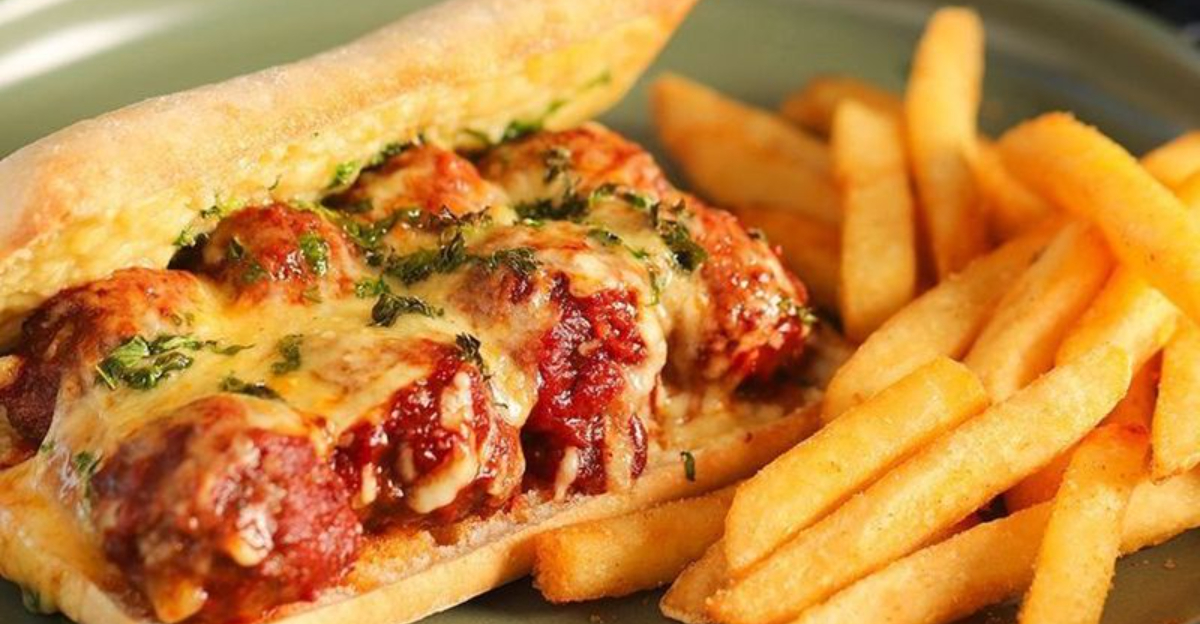15 Forgotten New Jersey Fast-Food Sandwiches That Deserve A Retro Revival

Remember a time when fast food spots in New Jersey weren’t just part of cookie-cutter chains, but rather places that offered unique local flavors?
Growing up in the Garden State during the 80s and 90s, I experienced the golden age of regional sandwich creations, where local favorites ruled the menu.
Over the years, however, many of these mouthwatering handheld meals have vanished, lost to the pressures of corporate standardization and ever-evolving tastes. Let’s take a flavorful trip down memory lane, revisiting some of New Jersey’s best sandwich creations that deserve to make a comeback and reclaim their place in our hearts (and bellies).
1. The Boardwalk Bomber
Atlantic City’s famous sandwich creation vanished in the early 2000s after a 30-year reign along the shore. I’ll never forget my dad bringing these home after work – a hollowed-out sub roll stuffed with crispy fried clams, tangy coleslaw, and a secret pepper sauce that gave it just enough kick without overwhelming the seafood.
The Bomber originated at Paulie’s Sandwich Shop near Steel Pier in 1973. What made it special was the bread – slightly toasted but still soft, creating the perfect vessel for those juicy ingredients.
Several shops tried copying it, but none captured the original’s perfect balance of crunch, creaminess, and seaside flavor.
2. The Rutgers Grease Truck Special
My freshman year at Rutgers introduced me to this legendary creation before the original food trucks were relocated in 2013. The sandwich that started the ‘Fat Sandwich’ craze wasn’t just food – it was a rite of passage.
Unlike today’s corporate versions, the original combined chicken fingers, mozzarella sticks, french fries, lettuce, tomato, and a mayo-ketchup sauce on a soft roll. The magic happened when everything melded together – crispy, gooey, fresh, and indulgent all at once.
Late-night study sessions weren’t complete without this massive handheld meal that somehow tasted even better at 2 AM.
3. The Trenton Tomato Torpedo
First created during the canning industry boom of the 1950s, this simple yet revolutionary sandwich showcased Jersey’s famous tomatoes like nothing else. Thick-sliced beefsteaks were marinated overnight in garlic vinaigrette, then layered with sharp provolone and roasted long hots on a crusty torpedo roll.
Torpedo Tony’s on Warren Street served these beauties until the mid-90s. The owner refused to use anything but local tomatoes, so the sandwich was only available from July through September.
What made it special was the way the bread soaked up those tomato juices without getting soggy – a technique that sadly disappeared when Tony retired.
4. The Meadowlands Meatball Monster
Before Giants Stadium became MetLife, tailgaters knew the best pre-game meal came from Vinnie’s truck in Lot J. His Meatball Monster combined traditional Italian meatballs with an unexpected twist – a layer of homemade hash browns between the meatballs and the roll!
The sandwich disappeared when the new stadium opened and vendor regulations changed. The contrast between those crispy potatoes and tender, fennel-spiked meatballs created a texture sensation that chain restaurants have never replicated.
Vinnie’s secret was using day-old semolina bread that stood up to the red sauce without disintegrating – plus that extra splash of anisette in the gravy.
5. The Princeton Pickle Pocket
This quirky creation from a tiny shop near campus combined unexpected flavors decades before “artisanal” sandwiches became trendy. Picture this: house-brined pickle spears, cream cheese blended with fresh dill, thin-sliced turkey, and potato chips all stuffed into a hollowed pumpernickel roll.
Students lined up between classes for this crunchy, creamy, salty delight until the shop closed in 2001. The owner, a former chemistry professor, claimed he developed the sandwich while experimenting with hangover cures for his students.
The combination sounds strange, but the contrasting textures and the way the pickle brine cut through the richness made it addictively good.
6. The Camden Shipyard Stack
Workers at the old New York Shipbuilding Corporation created this protein-packed powerhouse during WWII. My grandfather described it as “the sandwich that built battleships” – layers of thin-sliced roast beef, Lebanon bologna, and liverwurst with spicy mustard on thick-cut rye.
Local delis near the shipyard competed to make the best version until the facility closed in 1967. The unique combination reflected South Jersey’s diverse cultural influences, with German, Lebanese, and Italian workers all contributing elements.
The sandwich was traditionally wrapped in wax paper and newspaper, which supposedly added to the flavor as it sat in lunch pails during the morning shift.
7. The Wildwood Waffle Wonder
Summer vacations in the ’80s weren’t complete without this boardwalk breakfast sensation that vanished when the original creator retired. Belgian waffles, crisp on the outside and fluffy inside, replaced bread slices in this morning masterpiece stuffed with scrapple, scrambled egg, and American cheese.
Maple syrup was drizzled inside, creating that perfect sweet-savory combination that’s now trendy but was revolutionary back then. Eating one while walking the boards was a balancing act – sticky fingers guaranteed!
The tiny stand had lines around the block, especially after the bars closed and early-morning fishermen started their day. Nothing soaked up a night of boardwalk fun better.
8. The Hoboken Dock Deluxe
Long before Hoboken became gentrified, longshoremen fueled their shifts with this hearty creation from waterfront lunch carts. The Dock Deluxe layered capicola, mortadella, and provolone with roasted red peppers, but the magic ingredient was the olive spread – a family recipe guarded by the Italian families who ran the carts.
When container shipping transformed the industry in the 1970s, these lunch spots gradually disappeared. The sandwiches were wrapped in butcher paper and tied with string, allowing the flavors to meld during morning breaks.
Modern Italian delis have attempted to recreate it, but without those secret family recipes for the olive spread, something crucial is always missing.
9. The Pine Barrens Forager
This wild creation came from a roadside stand on Route 539 that served hunters and hikers exploring the Jersey Pinelands. Venison sausage patties topped with wild mushrooms, cranberry chutney, and sharp cheddar on a cornmeal-dusted roll celebrated the region’s unique ecosystem and heritage.
The stand operated seasonally from the 1970s until the early 2000s. Everything was locally sourced – the owner would only make the sandwiches when ingredients were available from area hunters and foragers.
The sweet-tart pop of those tiny Pine Barrens cranberries against the gamey sausage created a flavor profile you couldn’t find anywhere else – truly a taste of Jersey’s wild side.
10. The Asbury Park Rockin’ Reuben
When the Stone Pony was just getting started in the ’70s, musicians fueled up on this towering creation from a nearby deli. Unlike traditional Reubens, this version used Taylor ham instead of corned beef, layered with sauerkraut, Swiss cheese, and Russian dressing on marble rye.
The sandwich disappeared when the original deli closed during Asbury’s decline in the 1990s. Legend has it that Bruce Springsteen himself would order these between sets during his early days playing the circuit.
What made it special was how they grilled it – pressed between two heavy cast iron skillets that created the perfect crispy exterior while melting all those ingredients together inside.
11. The Newark Italian Dog Deluxe
Jimmy Buff’s original Italian hot dog had plenty of imitators, but few remember the short-lived Deluxe version that elevated this Newark classic to new heights. The Deluxe added homemade broccoli rabe and sharp provolone to the traditional mix of potatoes, peppers, and onions stuffed into pizza bread with two deep-fried hot dogs.
This variation only existed from 1978-1985 at a single location on Bloomfield Avenue. The bitter greens cut through the richness perfectly, while the sharp cheese added a tangy depth missing from the original.
My uncle swears the owner stopped making them because they were too labor-intensive, requiring three different cooking stations to assemble each one.
12. The Cape May Fisherman’s Breakfast
Before heading out to sea at dawn, Cape May fishermen lined up for this protein-packed morning meal that doubled as a sandwich. A fresh-baked buttermilk biscuit split and filled with creamed chipped beef, a fried egg, and crispy fried oysters created a savory symphony that sustained workers through rough morning waters.
The harbor café that created it closed in the 1980s when commercial fishing declined. What made it special was the contrast between the crunchy cornmeal-coated oysters and the creamy chipped beef gravy.
The owner’s daughter told me they went through 50 pounds of dried beef and 15 gallons of heavy cream every week making the gravy from her grandmother’s recipe.
13. The Montclair Art Student Special
This vegetarian masterpiece from a café near Montclair State University’s art department combined textures and flavors that were ahead of their time in the 1980s. Thick-sliced, olive oil-grilled eggplant, house-made hummus, roasted red peppers, cucumber, and feta were stacked on olive bread with a smear of harissa yogurt.
When the original owners sold the café in 2005, the new management streamlined the menu. Students would sketch while waiting in the perpetually long lunch line, and the café walls were covered in artwork traded for sandwiches.
The combination represented North Jersey’s diverse Mediterranean influences, with Greek, Italian, and Middle Eastern elements harmonizing perfectly in each bite.
14. The Atlantic Highlands Clamwich
Weekend fishing trips with my uncle always ended with this seafood specialty from a marina shack that operated from the 1960s until Hurricane Sandy. Fresh-shucked local clams were lightly breaded, quickly fried, and piled onto a buttered, grilled split-top roll with homemade tartar sauce and thin-sliced raw onion.
The sandwich came wrapped in yesterday’s Asbury Park Press, creating an impromptu plate as you peeled back the layers. What made it memorable was the contrast between those crispy, briny clams and the sweet, buttery roll.
The owner claimed the secret was frying in a mixture of vegetable oil and rendered bacon fat – not exactly heart-healthy, but absolutely delicious!
15. The Ironbound Portuguese Crusher
Newark’s Ironbound district has always been a culinary treasure, but this 1990s creation from a Ferry Street lunch counter sadly disappeared when the original chef retired. Grilled linguiça sausage, bacalhau (salt cod) salad, and piri-piri pepper sauce were layered on a papo seco roll with a schmear of garlic butter.
The combination of smoky, spicy, and briny flavors represented the Portuguese community’s rich culinary heritage. The sandwich got its name because it was pressed under a brick on the grill, creating a compact, flavor-packed meal.
I still dream about how the crusty bread soaked up those amazing juices without falling apart – a structural and gastronomic marvel!
